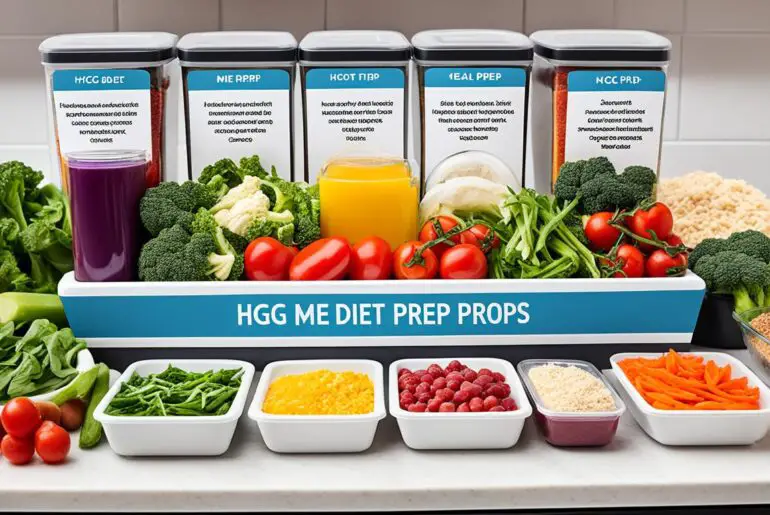
Did you know that the average American spends nearly $60 billion each year on weight loss products and services? Despite this staggering expenditure, more than two-thirds of adults in the United States are still overweight or obese. If you’re among those looking to shed extra pounds, it’s essential to understand the different weight loss protocols available, such as the HCG Diet and the Atkins Diet. These two popular diets involve specific phases that can significantly impact your weight loss journey.
Key Takeaways:
- The HCG Diet and Atkins Diet are both popular weight loss protocols.
- The HCG Diet uses the hormone HCG and restricts calorie intake, while the Atkins Diet is a low-carbohydrate eating plan.
- Understanding the differences between these two diets can help you make an informed decision about which one is best for you.
- The HCG Diet consists of three phases: loading, maintenance, and stabilization.
- The Atkins Diet has four phases: induction, balancing, pre-maintenance, and lifetime maintenance.
What is the Atkins Diet?
The Atkins Diet, developed by cardiologist Robert C. Atkins, is a popular low-carbohydrate eating plan that focuses on restricting carbohydrate intake and emphasizing protein and fats. With several phases designed for weight loss and maintenance, the Atkins Diet has gained recognition for starting the low-carb diet trend and has been extensively documented in various books.
The Atkins Diet offers a unique approach to weight management by significantly reducing carbohydrate consumption and prioritizing protein and fat sources. This dietary plan aims to shift the body’s metabolism from using carbohydrates as its primary fuel source to burning stored fat for energy. By limiting carbohydrate intake, the body enters a state of ketosis, where it begins utilizing stored fat as its primary energy source.
Counting carbohydrates is a fundamental principle of the Atkins Diet. It involves monitoring the net carbs consumed, which is calculated by subtracting the fiber and sugar alcohol content from the total carbohydrate count. By strategically choosing foods low in net carbs, individuals following the Atkins Diet can achieve weight loss and maintenance goals.
Let’s explore the different phases of the Atkins Diet in more detail:
What is the Purpose of the Atkins Diet?
The purpose of the Atkins Diet is to change eating habits, promote weight loss, and improve overall health. Unlike traditional diets that focus on calorie counting, the Atkins Diet emphasizes the importance of controlling carbohydrate intake to achieve weight loss and maintain optimal health.
The Atkins Diet is designed to be a lifelong approach to eating, providing individuals with the tools to make lasting changes to their dietary habits. By reducing the consumption of carbohydrates, the diet encourages the body to burn stored fat for energy, resulting in weight loss.
In addition to weight loss, the Atkins Diet is also known for its potential to increase energy levels and improve health conditions such as high blood pressure and metabolic syndrome. By limiting the intake of carbohydrates that can spike blood sugar levels, the diet may help stabilize blood pressure and blood sugar levels.
| Key Benefits of the Atkins Diet | Risks of the Atkins Diet |
|---|---|
|
|
It is important to note that while the Atkins Diet can be effective for weight loss and improving certain health conditions, it may not be suitable for everyone. Before starting any diet or weight loss program, it is recommended to consult with a healthcare provider to ensure it aligns with your individual health goals and needs.
References:
- Atkins. (2021). The Atkins Diet. Retrieved from [insert website link].
- Harvard Health Publishing. (2020). Are low-carb diets healthy? Retrieved from [insert website link].
Why Choose the Atkins Diet?
When it comes to weight loss diets, the Atkins Diet offers several compelling reasons for individuals to choose this approach. Here are some key factors that make the Atkins Diet an attractive option:
- Enjoyment of Featured Foods: One of the reasons individuals choose the Atkins Diet is because they can enjoy a wide variety of delicious foods. From savory proteins like fish, poultry, and meat to flavorful fats like avocados and olive oil, the diet allows for indulgence in satisfying meals.
- Restriction of Certain Carbs: With the Atkins Diet, individuals have the opportunity to restrict certain carbohydrates, particularly those found in refined sugars and processed grains. This carb restriction can aid in weight loss and help regulate blood sugar levels.
- Change in Overall Eating Habits: The Atkins Diet is not just a temporary weight loss solution but also a lifestyle change. By following the diet, individuals can develop healthier eating habits that can be sustained in the long run.
- Improvement in Health Concerns: Another notable reason to choose the Atkins Diet is its potential to address various health concerns. Research suggests that the diet may help improve conditions such as high blood pressure and metabolic syndrome, thanks to its emphasis on low-carbohydrate intake.
Before starting any weight-loss diet, especially for individuals with existing health conditions, it is crucial to consult with a healthcare provider to ensure safety and appropriateness.
The Phases of the Atkins Diet
https://www.youtube.com/watch?v=fes2cXCXpa8
The Atkins Diet consists of four phases that individuals can choose based on their weight-loss goals. Each phase has its purpose and guidelines to ensure effective and sustainable weight loss.
1. Induction Phase
The Induction phase is the first and strictest phase of the Atkins Diet. During this phase, carbohydrate intake is limited to 20 grams per day. The focus is on consuming protein-rich foods and allowing certain low-carbohydrate vegetables. This phase typically lasts for two weeks and kickstarts the fat-burning process.
2. Balancing Phase
After completing the Induction phase, individuals move on to the Balancing phase. The goal of this phase is to gradually reintroduce carbohydrates into the diet while still promoting weight loss. The daily carbohydrate intake is increased to 40 grams net carbs per day, primarily from nutrient-rich sources like vegetables and berries. This phase is suitable for individuals who have less than 40 pounds to lose.
3. Pre-maintenance Phase
Once desired weight loss is achieved, individuals enter the Pre-maintenance phase. In this phase, more foods are added to the diet, including fruits, starchy vegetables, and whole grains. The objective is to find the personal carbohydrate balance that allows for weight maintenance without gaining or losing weight. This phase helps individuals transition to a long-term approach of maintaining their goal weight with a balanced diet.
4. Lifetime Maintenance Phase
The Lifetime maintenance phase is the final phase of the Atkins Diet. In this phase, individuals have reached their weight goal and focus on maintaining their success. It involves following a balanced diet that includes a variety of foods while keeping the principles of the Atkins Diet in mind. The emphasis is on sustainable, healthy eating patterns for lifelong weight management.
It’s important to note that the duration of each phase may vary depending on individual weight-loss goals and progress. Consulting with a healthcare professional or a registered dietitian can provide personalized guidance and recommendations throughout the different phases of the Atkins Diet journey.
| Phase | Carbohydrate Intake | Main Focus | Allowed Foods |
|---|---|---|---|
| Induction phase | 20 grams per day | Protein intake and ketosis | Protein-rich foods, certain low-carbohydrate vegetables |
| Balancing phase | 40 grams net carbs per day | Gradually reintroducing carbs | Vegetables, berries, and other nutrient-rich sources of carbohydrates |
| Pre-maintenance phase | Varies based on individual | Finding personal carbohydrate balance | Fruits, starchy vegetables, whole grains |
| Lifetime maintenance phase | Maintenance level | Long-term weight management | Varied and balanced diet |
The HCG Diet: An Overview

The HCG Diet is a weight loss protocol that utilizes human chorionic gonadotrophin (HCG), a hormone naturally produced during pregnancy. This diet was developed by Dr. A.T. Simeons and is known for its strict calorie restriction phase. During this phase, individuals are limited to consuming only 500 calories per day. It is important to note that the HCG Diet is not intended as a long-term solution, and individuals are expected to gradually transition back to a normal diet once the phases are completed.
Three Phases of the HCG Diet
The HCG Diet consists of three main phases: the loading phase, the maintenance phase, and the stabilization phase.
- 1. Loading Phase: This initial phase lasts for two days and allows individuals to consume high-calorie foods freely. The purpose of this phase is to prepare the body for the calorie-restricted phase that follows.
- 2. Maintenance Phase: The maintenance phase is the core of the HCG Diet and involves the strict calorie restriction of 500 calories per day for a specific duration, typically around three weeks. During this phase, individuals are encouraged to consume lean proteins, vegetables, and some fruits.
- 3. Stabilization Phase: After completing the maintenance phase, individuals move into the stabilization phase. This phase allows for a gradual transition back to a normal diet. It focuses on maintaining the weight loss achieved in the previous phases and stabilizing the metabolism.
Benefits and Considerations
The HCG Diet claims to offer several benefits, including rapid weight loss and a structured eating plan. However, it is essential to consider the potential risks and consult with a healthcare provider before starting this diet.
“The HCG Diet can lead to significant weight loss results, but it is important to carefully follow the guidelines and monitor any potential side effects.”
Calorie restriction diets like the HCG Diet can have an impact on energy levels and may not be suitable for everyone. It is crucial to ensure that nutritional requirements are met and that the diet is followed under medical supervision.
Understanding the HCG Diet Phases
The HCG Diet consists of three main phases: the loading phase, maintenance phase, and stabilization phase. Each phase serves a specific purpose in the overall weight loss journey.
1. Loading Phase
The loading phase is the initial phase of the HCG Diet, lasting for the first two days. During this phase, individuals are encouraged to eat whatever they want, focusing on high-fat and calorie-dense foods. This phase helps prepare the body for the calorie restriction in the subsequent phases.
2. Maintenance Phase
The maintenance phase is the strictest phase of the HCG Diet and typically lasts for three weeks. During this phase, individuals are required to consume only 500 calories per day. It is essential to follow the prescribed calorie restriction while choosing healthy, organic foods to ensure proper nutrition. This phase is crucial for achieving significant weight loss.
3. Stabilization Phase
The stabilization phase marks the transition back to a normal diet after completing the maintenance phase. It typically lasts for three weeks and focuses on gradually increasing caloric intake while maintaining the weight loss achieved during the previous phases. This phase helps the body adjust to the increased calorie consumption and prevents rapid weight regain.
“The HCG Diet requires individuals to navigate through three distinct phases, each serving a unique purpose in the weight loss journey.”
| Phase | Description |
|---|---|
| Loading Phase | Allows individuals to eat whatever they want for the first two days to prepare the body for the calorie restriction. |
| Maintenance Phase | Involves consuming only 500 calories per day for three weeks while focusing on healthy, organic foods. |
| Stabilization Phase | Marks the transition back to a normal diet, gradually increasing caloric intake while maintaining weight loss. |
Benefits and Risks of the HCG Diet

The HCG Diet offers several potential benefits for individuals looking to lose weight and adhere to clear guidelines. One of the claimed benefits is increased energy levels throughout the diet. By following the prescribed calorie restrictions and consuming nutrient-dense foods, individuals on the HCG Diet may experience a boost in energy.
A primary goal of the HCG Diet is weight loss, which is achieved through a combination of calorie restriction and the influence of the human chorionic gonadotrophin (HCG) hormone. This hormone is believed to help curb hunger and maintain muscle mass while losing weight.
Clear guidelines are an essential aspect of the HCG Diet. The diet plan provides specific instructions on caloric intake, food choices, and portion sizes, allowing individuals to follow a structured and straightforward approach to weight loss.
Despite these potential benefits, it’s important to consider the risks associated with such a low-calorie diet. Restricting calories to a drastic extent can place stress on the body, potentially leading to the release of cortisol. This hormone is involved in fat storage and can interfere with weight loss efforts.
Additionally, the extremely low-calorie intake of the HCG Diet may contribute to a decreased metabolism. When the body is consistently deprived of calories, it may enter a state of conservation, making it more challenging to burn fat efficiently. This can result in a slower rate of weight loss as the body adapts to the reduced calorie intake.
Individuals considering the HCG Diet should carefully weigh the potential benefits and risks before starting the program. Consulting with a healthcare professional is crucial to ensure the suitability and safety of such a low-calorie diet for an individual’s specific needs and health conditions.
Risks of the HCG Diet
“Restricting calories to such a low level puts stress on the body and can lead to the release of cortisol, a hormone that contributes to fat storage.”
| Benefits of the HCG Diet | Risks of the HCG Diet |
|---|---|
|
|
Atkins Diet Phase 1: Induction Phase
The Induction phase of the Atkins Diet is the first and strictest phase in the weight loss protocol. During this phase, individuals restrict their carbohydrate intake to 20 grams per day, focusing on consuming adequate amounts of protein. This phase aims to kickstart the body’s fat-burning process through carbohydrate restriction and a protein-centric approach.
In the Induction phase, emphasis is placed on consuming protein-rich foods, such as fish, shellfish, poultry, meat, eggs, and cheese. These foods provide essential nutrients while keeping carbohydrate consumption low. It is important to avoid high-carbohydrate foods like fruits, sugary baked goods, breads, pastas, grains, nuts, and alcohol during this phase.
The Induction phase typically lasts for at least two weeks, depending on an individual’s weight loss goals. It is designed to help individuals transition into a state of ketosis, where the body starts utilizing stored fat as its primary source of energy. This phase jumpstarts weight loss by curbing carbohydrates and focusing on nutrient-dense, protein-rich foods.
The Induction phase serves as a foundation for the subsequent phases of the Atkins Diet, allowing individuals to adjust their carbohydrate intake based on weight loss progress and personal preferences.
Benefits of the Induction Phase:
- Initiates ketosis for accelerated fat burning
- Curbs cravings for high-carbohydrate foods
- Jumpstarts weight loss
- Increases satiety with protein-rich foods
“The Induction phase of the Atkins Diet sets the stage for successful weight loss by restricting carbohydrate intake and focusing on protein consumption.” – Dr. Robert C. Atkins
By adhering to the Induction phase, individuals can experience significant weight loss results and establish a solid foundation for long-term success on the Atkins Diet.
| Allowed Foods | Avoided Foods |
|---|---|
| Fish | Fruits |
| Shellfish | Sugary baked goods |
| Poultry | Breads |
| Meat | Pastas |
| Eggs | Grains |
| Cheese | Nuts |
| Alcohol |
Atkins Diet Phase 2: Balancing Phase

The Balancing phase of the Atkins Diet is a crucial step in the weight loss journey. In this phase, individuals can reintroduce a controlled amount of carbohydrates into their diet while still maintaining progress towards their weight loss goals. This phase is designed to strike a balance between weight loss and sustainable eating habits.
During the Balancing phase, individuals are allowed to have 40 grams of net carbs per day. These carbs should come primarily from nutrient-rich sources such as vegetables and berries. This gradual reintroduction of carbs allows the body to adjust and find its optimal carbohydrate tolerance.
This phase is suitable for individuals who have less than 40 pounds to lose. It provides more flexibility in food choices while ensuring that weight loss is still prioritized. By gradually increasing carb intake, individuals can discover what works best for their bodies and make informed choices about their dietary preferences.
While the Balancing phase allows for more variety in food choices, it is important to stay within the recommended carbohydrate limit. This ensures that the body remains in a state of ketosis, a metabolic state where the body burns fat for fuel. By maintaining ketosis, individuals can continue to experience the benefits of weight loss that the Atkins Diet offers.
The Balancing phase is an essential component of the Atkins Diet. It allows individuals to enjoy a wider range of foods while still achieving their weight loss goals. By following this phase correctly and adhering to the guidelines, individuals can continue on their journey towards improved health and sustainable weight loss.
Atkins Diet Phase 3: Pre-Maintenance Phase

The Pre-maintenance phase of the Atkins Diet is an essential step in transitioning to weight maintenance. In this phase, individuals have successfully reached their weight loss goals and are now focused on maintaining their progress. It is a crucial stage that allows for an expanded food range and helps individuals find their personal carbohydrate balance.
During the Pre-maintenance phase, individuals slowly increase their carbohydrate intake, including a wider variety of foods such as fruits, starchy vegetables, and whole grains. This gradual reintroduction of carbs helps the body adjust to a more balanced and sustainable eating pattern.
The goal of the Pre-maintenance phase is to find the personal carbohydrate balance that allows individuals to maintain their weight without gaining or losing. It is the number of grams of net carbs that can be consumed each day without affecting weight. Determining this balance is unique to each individual and may require some experimentation.
It is important to note that the Pre-maintenance phase is not a free-for-all when it comes to carb consumption. It still requires mindful eating and portion control. By monitoring their carbohydrate intake and making informed choices, individuals can find the right balance that allows them to enjoy a wider range of foods while maintaining their weight loss.
Benefits of the Pre-Maintenance Phase:
- Expanded food range: The Pre-maintenance phase allows for the inclusion of fruits, starchy vegetables, and whole grains, providing individuals with more variety in their diet.
- Flexibility: With an expanded food range, individuals have more options and flexibility in their meal planning, making it easier to sustain the diet long-term.
- Weight maintenance: The Pre-maintenance phase is crucial for establishing a sustainable eating pattern that supports maintaining weight loss in the long run.
My Recommended Approach:
“During the Pre-maintenance phase, it is important to focus on finding a balance that works for you. Gradually introduce additional carbohydrates while monitoring your weight. If you find yourself gaining or losing weight, adjust your carbohydrate intake accordingly. Remember, this phase is about finding a sustainable eating pattern that allows you to maintain your weight loss and enjoy a variety of foods.”
By following the Pre-maintenance phase of the Atkins Diet, individuals can successfully transition from weight loss to weight maintenance. Finding the right balance of carbohydrates and maintaining healthy eating habits is key to long-term success. This phase sets the foundation for a lifetime of healthy eating and weight management.
Conclusion
In conclusion, both the HCG Diet Phases and Atkins Diet Phases offer different approaches to weight loss. The HCG Diet involves a strict calorie restriction phase with the use of the hormone HCG, while the Atkins Diet focuses on low-carbohydrate eating. Choosing between these two protocols ultimately depends on individual preference and goals. It is important to consult with a healthcare provider and consider the potential risks and benefits of each diet before making a decision.
FAQ
What are the phases of the HCG Diet and the Atkins Diet?
The HCG Diet consists of the loading phase, maintenance phase, and stabilization phase. The Atkins Diet has four phases: Induction phase, Balancing phase, Pre-maintenance phase, and Lifetime maintenance phase.
What is the Atkins Diet?
The Atkins Diet is a popular low-carbohydrate eating plan that focuses on protein and fats. It aims to restrict carbohydrate intake and has several phases for weight loss and maintenance.
What is the purpose of the Atkins Diet?
The purpose of the Atkins Diet is to help individuals change their eating habits, lose weight, and maintain weight loss. It emphasizes controlling carbohydrate intake and encourages the consumption of more protein and fat.
Why would someone choose the Atkins Diet?
Individuals may choose the Atkins Diet because they enjoy the types and amounts of food featured in the diet, appreciate its ability to restrict certain carbs for weight loss, or want to change their overall eating habits and improve specific health concerns.
What are the phases of the Atkins Diet?
The phases of the Atkins Diet are the Induction phase, Balancing phase, Pre-maintenance phase, and Lifetime maintenance phase.
What is the HCG Diet?
The HCG Diet is a weight loss protocol that involves the use of the hormone human chorionic gonadotrophin (HCG) and a strict calorie restriction phase. It consists of three main phases: loading phase, maintenance phase, and stabilization phase.
What are the phases of the HCG Diet?
The phases of the HCG Diet are the loading phase, maintenance phase, and stabilization phase.
What are the benefits and risks of the HCG Diet?
The HCG Diet claims benefits such as increased energy, weight loss, and clear guidelines. However, risks include stress on the body, cortisol release, and decreased metabolism due to the extremely low-calorie intake.
What is the Atkins Diet Phase 1: Induction Phase?
The Induction phase is the first and strictest phase of the Atkins Diet. It involves restricting carbohydrates to 20 grams per day and focusing on protein consumption.
What is the Atkins Diet Phase 2: Balancing Phase?
The Balancing phase allows for a gradual reintroduction of carbohydrates. Individuals can have up to 40 grams of net carbs per day from nutrient-rich sources like vegetables and berries.
What is the Atkins Diet Phase 3: Pre-Maintenance Phase?
The Pre-maintenance phase marks the transition to weight maintenance. Individuals slowly increase their carbohydrate intake, including fruits, starchy vegetables, and whole grains.
What should I consider when choosing between the HCG Diet Phases and the Atkins Diet Phases?
When choosing between the HCG Diet Phases and the Atkins Diet Phases, it is important to consider individual preferences, weight loss goals, and any potential risks associated with each diet. Consulting with a healthcare provider is also recommended.



